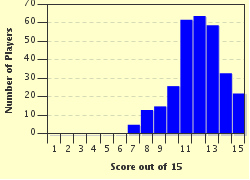Quiz Answer Key and Fun Facts
1. The Sun is the only star to harbor planets.
2. Sea of Tranquility is found on Earth.
3. The melting point of mercury is 38°F (3°C).
4. Jupiter is the solar system's biggest planet.
5. Excess salt in your diet can have negative effects on your health.
6. Momentum is a product of the mass and velocity of an object.
7. Omnivores eat plants only.
8. When talking about calories in nutrition, the actual unit referred to is kilocalories.
9. Sun exposure can cause brown spots (age spots) on the skin.
10. The kilosecond is a commonly used unit.
11. The expansion of the universe is slowing down due to gravity.
12. Tornado winds can sometimes reach 300 mph (480 kph).
13. The cerebral cortex of the human brain is divided into four lobes.
14. Atoms contain nuclei.
15. The brightest star, Sirius, is part of the constellation Orion.
Source: Author
Earthboy
This quiz was reviewed by FunTrivia editor
WesleyCrusher before going online.
Any errors found in FunTrivia content are routinely corrected through our feedback system.


